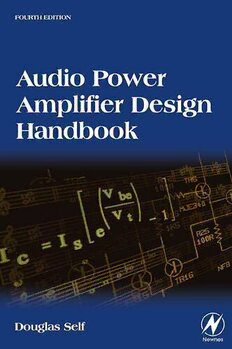
Audio Power Amplifier Design Handbook PDF
Preview Audio Power Amplifier Design Handbook
Audio Power Amplifier Design Handbook This Page is Intentionally Left Blank Audio Power Amplifier Design Handbook Fourth edition Douglas Self MA, MSc AMSTERDAM•BOSTON•HEIDELBERG•LONDON•NEWYORK•OXFORD PARIS•SANDIEGO•SANFRANCISCO•SINGAPORE•SYDNEY•TOKYO NewnesisanimprintofElsevier NewnesisanimprintofElsevier LinacreHouse,JordanHill,OxfordOX28DP 30CorporateDrive,Burlington,MA01803 Firstpublished2006 Copyright©2006,DouglasSelf.Allrightsreserved TherightofDouglasSelftobeidentifiedastheauthorofthisworkhasbeen assertedinaccordancewiththeCopyright,DesignsandPatentsAct1988 Nopartofthispublicationmaybereproducedinanymaterialform(including photocopyingorstoringinanymediumbyelectronicmeansandwhetherornot transientlyorincidentallytosomeotheruseofthispublication)withoutthewritten permissionofthecopyrightholderexceptinaccordancewiththeprovisionsofthe Copyright,DesignsandPatentsAct1988orunderthetermsofalicenceissued bytheCopyrightLicensingAgencyLtd,90TottenhamCourtRoad,London, EnglandW1T4LP.Applicationsforthecopyrightholder’swrittenpermissionto reproduceanypartofthispublicationshouldbeaddressedtothepublisher PermissionsmaybesoughtdirectlyfromElsevier’sScienceandTechnologyRights DepartmentinOxford,UK:phone:(+44)(0)1865843830;fax:(+44)(0)1865 853333;e-mail:[email protected] on-lineviatheElsevierhomepage(http://www.elsevier.com),byselecting ‘CustomerSupport’andthen‘ObtainingPermissions’ BritishLibraryCataloguinginPublicationData Self,Douglas Audiopoweramplifierdesignhandbook.—4thed. 1. Audioamplifiers—Design 2. Poweramplifiers—Design I. Title 621.3′81535 LibraryofCongressControlNumber: 2006927666 ISBN-13:978-0-7506-8072-1 ISBN-10:0-7506-8072-5 ForinformationonallNewnespublications visitourwebsiteatwww.newnespress.com PrintedandboundinGreatBritain 06 07 08 09 10 10 9 8 7 6 5 4 3 2 1 Working together to grow libraries in developing countries www.elsevier.com | www.bookaid.org | www.sabre.org Contents Synopsis vii PrefacetoFourthEdition xvii Preface xviii 1. Introductionandgeneralsurvey 1 2. History,architectureandnegativefeedback 31 3. Thegeneralprinciplesofpoweramplifiers 62 4. Thesmallsignalstages 75 5. TheoutputstageI 109 6. TheoutputstageII 166 7. Compensation,slew-rate,andstability 186 8. PowersuppliesandPSRR 239 9. Class-Apoweramplifiers 259 10. Class-Gpoweramplifiers 294 11. Class-Damplifiers 319 12. FEToutputstages 328 13. Thermalcompensationandthermaldynamics 339 14. ThedesignofDCservos 385 15. Amplifierandloudspeakerprotection 397 16. Groundingandpracticalmatters 432 17. Testingandsafety 454 Index 464 v This Page is Intentionally Left Blank Synopsis Chapter 1 Introduction and general survey Theeconomicimportanceofpoweramplifiers Assumptions Originsandaims Thestudyofamplifierdesign Misinformationinaudio Scienceandsubjectivism TheSubjectivistposition Ashorthistoryofsubjectivism Thelimitsofhearing Articlesoffaith:thetenetsofsubjectivism Thelengthoftheaudiochain Theimplications Thereasonswhy Theoutlook Technicalerrors Theperformancerequirementsforamplifiers Safety Reliability Poweroutput Frequencyresponse Noise Distortion Dampingfactor Absolutephase Acronyms Chapter 2 History, architecture and negative feedback Abriefhistoryofamplifiers Amplifierarchitectures vii Synopsis Thethree-stagearchitecture Thetwo-stageamplifierarchitecture Poweramplifierclasses Class-A Class-AB Class-B Class-C Class-D Class-E Class-F Class-G Class-H Class-S VariationsonClass-B Error-correctingamplifiers Non-switchingamplifiers Current-driveamplifiers TheBlomleyprinciple GeometricmeanClass-AB Nesteddifferentiatingfeedbackloops AC-andDC-coupledamplifiers TheadvantagesofAC-coupling TheadvantagesofDC-coupling Negativefeedbackinpoweramplifiers Somecommonmisconceptionsaboutnegativefeedback AmplifierstabilityandNFB MaximisingtheNFB Maximisinglinearitybeforefeedback Chapter 3 The general principles of power amplifiers Howagenericamplifierworks Theadvantagesofconvention Theeightdistortions Distortionone:inputstagedistortion Distortiontwo:VASdistortion Distortionthree:outputstagedistortion Distortionfour:VASloadingdistortion Distortionfive:raildecouplingdistortion Distortionsix:inductiondistortion Distortionseven:NFBtakeoffdistortion Distortioneight:capacitordistortion Non-existentdistortions Theperformanceofastandardamplifier Open-looplinearityandhowtodetermineit viii Synopsis Directopen-loopgainmeasurement Usingmodelamplifiers Theconceptoftheblamelessamplifier Chapter 4 The small signal stages Theroleoftheinputstage Distortionfromtheinputstage BJTsvsFETsfortheinputstage AdvantagesoftheFETinputstage DisadvantagesofFETinputstage Singletoninputstageversusdifferentialpair Theinputstagedistortioninisolation Inputstagebalance Thejoyofcurrent-mirrors Improvinginput-stagelinearity Radicalmethodsofimprovinginputlinearity Inputstagecascodeconfigurations Inputnoiseandhowtoreduceit Offsetandmatch:theDCprecisionissue Theinputstageandtheslew-rate Thevoltage-amplifierstage MeasuringVASdistortioninisolation VASoperation VASdistortion LinearisingtheVAS:activeloadtechniques VASenhancements Theimportanceofvoltagedrive ThebalancedVAS TheVASandmanipulatingopen-loopbandwidth Manipulatingopen-loopbandwidth Conclusions Chapter 5 The output stage I Classesanddevices Thedistortionsoftheoutput Harmonicgenerationbycrossoverdistortion Comparingoutputstages Theemitter-followeroutput TheCFPoutput Quasi-complementaryoutputs Triple-basedoutputconfigurations TripleEFoutputstages Distortionanditsmechanisms ix
